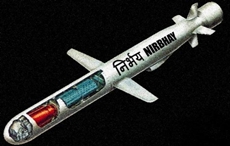|
A day after the long-range cruise missile 'Nirbhay' deviated from its course during its maiden launch off the Odisha coast and had to be destroyed in mid-air, scientists of the Defence Research & Development Organisation (DRDO) today began the post-mission analysis to locate the fault.  The sub-sonic missile that was launched from the Integrated Test Range at Chandipur-on-sea in Balasore district, about 230 km from here, deviated from its intended course after travelling approximately half its course. The sub-sonic missile that was launched from the Integrated Test Range at Chandipur-on-sea in Balasore district, about 230 km from here, deviated from its intended course after travelling approximately half its course.
Scientists of the DRDO who were involved in the development and launch of the missile met at Chandipur and started analysing the telemetry data. "We should not rush to any conclusion because it involves a large amount of data. We are doing a very, very thorough investigation," a scientist involved in the mission told IANS. "It will take at least a month," said the scientist on the expected time required to complete the investigation. He said the post-mission analysis committee has already started looking into the matter. Describing the test, senior scientists said the launch was perfect and the booster established the missile in cruise mode correctly. Nirbhay flew more than 200 km along the Odisha coast, skimming the Bay of Bengal, watched by radars along the coastline. The navigation too was perfect, with the Nirbhay correctly touching the first two ''way-points'', which marked the route that the missile was to take. Things went wrong after 15 minutes of flight, when the missile deviated significantly from its path. Since it was close to the inhabited coastline, a self-destruct mechanism inside the missile was activated to destroy it. Avinash Chander, DRDO's missile chief and a key architect of the Agni ballistic missile programme, said, ''I would call the test 80 per cent successful. The Nirbhay demonstrated that it could take off correctly, establish a cruise profile, and navigate to its initial waypoints. ''These were new performance parameters that we had never tested before, so we are satisfied that the test proved those. But then, one of the sub-systems malfunctioned and we had to terminate the test. All that remains is to determine why this happened and to rectify the flaw.'' The Nirbhay missile is claimed to be similar to the US Tomahawk, which can fly like an airplane and is capable of travelling up to 1,000 km. Developed by the Aeronautical Development Establishment (ADE), a DRDO laboratory based in Bangalore, Nirbhay could be launched from land, sea or air. The surface-to-surface missile has good loitering capability, advanced navigation system and can provide high degree of accuracy. It can travel at a very low altitude at a speed of 0.7 mach (nearly 840kmph) and has the ability to fly around the target till it gets an opportunity to attack it. A key hurdle to developing a long-range cruise missile is the Missile Technology Control Regime (MTCR), which forbids signatories from assisting or providing technology to any other country developing a cruise missile with a range of 300 km or more. India and Russia could collaborate in developing the Brahmos supersonic cruise missile because its range was pegged at 295 km, just below the MTCR limit. In building the Nirbhay, however, India has had to go it alone.
|